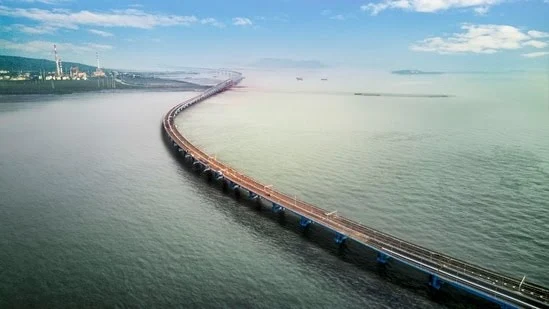Get ready for a historic day in Mumbai! Prime Minister Narendra Modi himself will be opening the doors to the stunning Mumbai Trans Harbour Link, India's very own champion of sea bridges. This marvel of engineering stretches a whopping 21.8 kilometers, officially named the Atal Bihari Vajpayee Sewri-Nhava Sheva Atal Setu. Prepare to be blown away by its breathtaking views and the promise of a faster, smoother journey between Mumbai and Navi Mumbai! It will not only be India's longest sea bridge but also one of the strongest, built with cutting-edge earthquake-resistant technology. This engineering marvel stretches an impressive 21 kilometers across the Mumbai harbor, connecting Navi Mumbai to Sewri in Mumbai. Remember those two-hour commutes that felt like forever? This new option will make them a distant memory, getting you there in a quick 15-20 minutes.
 |
| (Credit:PTI) Atal Bihari Vajpayee Sewri-Nhava Sheva Atal Setu |
Building this bridge was a huge project! It took more than nine years and cost a whopping ₹17,840 crore. But beyond its sheer size and grandeur, what truly sets Atal Setu apart is its resilience in the face of natural disasters.
Read More: Perth to Become Home to World's Tallest Ram Temple, a 721-Foot Monument to Hindu Culture
Read More: National Park Not a Place for Tiger Zoos, Declares Supreme Court, Thwarting Corbett Safari Plans
Read More: Ancient Sentinels: 385-Million-Year-Old Forest Unearthed in Upstate New York
Built to Withstand the Tremors
Mumbai lies in a Zone III earthquake zone, meaning it faces moderate risk of tremors. The engineers knew earthquakes were a risk, so they designed the bridge with special features to make it super stable during a tremor.
1) High Damping Rubber Bearings: These specialized bearings act as shock absorbers, dissipating the energy of earthquake waves and preventing excessive vibrations that could damage the bridge's structure.
2) Base Isolation: The bridge's foundations are isolated from the superstructure using a layer of elastomeric pads. This decoupling allows the ground to move during an earthquake while keeping the bridge itself relatively stable.
3) Post-Tensioning: High-strength steel tendons are strategically placed within the concrete structure and then tensioned, pre-stressing the concrete and making it more resistant to cracking under seismic stress.
IIT Bombay Expert Weighs In
Professor Arvind Kumar, head of the Department of Civil Engineering at IIT Bombay, lauded the incorporation of these earthquake-resistant technologies in Atal Setu.
"The bridge's design takes into account the specific seismic vulnerabilities of the region," he said. "The use of high damping rubber bearings, base isolation, and post-tensioning techniques will significantly enhance the bridge's ability to withstand earthquakes."
A Beacon of Engineering Excellence
The Atal Setu is more than concrete and steel, it's a symbol of India's growing muscle in building big things! Built to endure earthquakes, it raises the safety bar for future projects, making them more resistant to natural disasters. It's like a champion showing the way for future constructions to be tough as nails!
This new bridge in Mumbai is a game changer! It'll make getting around so much easier, not just for the city itself but for the whole country. Having good roads and bridges is important everywhere, but you especially want them to be strong in places that get earthquakes.
The Atal Setu isn't just a bridge, it's a giant leap forward for India! It really shows what our Indian engineers can do. If we can build something like this, we can achieve anything we set our goals on! Sure, it connects cities, but it also sends a message: India is all about building a brighter future. It just makes you feel proud to be Indian, doesn't it? Makes you think we can build anything we set our minds to.
All About The MUMBAI TRANS HARBOUR LINK
1) The bridge is about 21.8 km long, including a six-lane stretch covering approximately 16.5 km over the sea and around 5.5 km on land. Its purpose is to improve connectivity to both Mumbai International Airport and Navi Mumbai International Airport, reducing travel time to Pune, Goa, and South India from Mumbai. Additionally, it aims to enhance the link between Mumbai Port and Jawaharlal Nehru Port, according to the release.
2) Mumbai Police has set a maximum speed limit of 100 kilometers per hour for four-wheelers on the MTHL. Motorbikes, autorickshaws, and tractors are prohibited on the sea bridge. Cars, taxis, light motor vehicles, minibuses, and two-axle buses are allowed to travel at a speed of 100 kilometers per hour, but the speed is limited to 40 kilometers per hour during the ascent and descent of the bridge.
3) A one-way toll for a passenger car on the MTHL is Rs 250. The charges for return journeys and for daily or frequent travelers will vary.
 |
| Credit: Dev Kotak |




.jpg)

%20(1).jpg)

0 Comments
Do Share Your Views